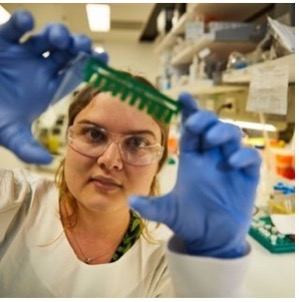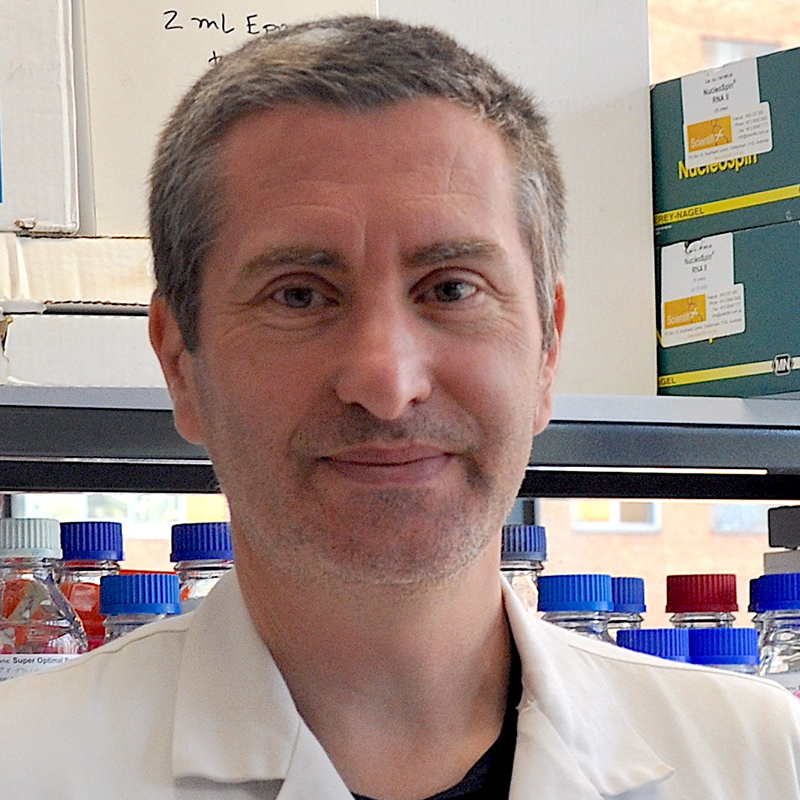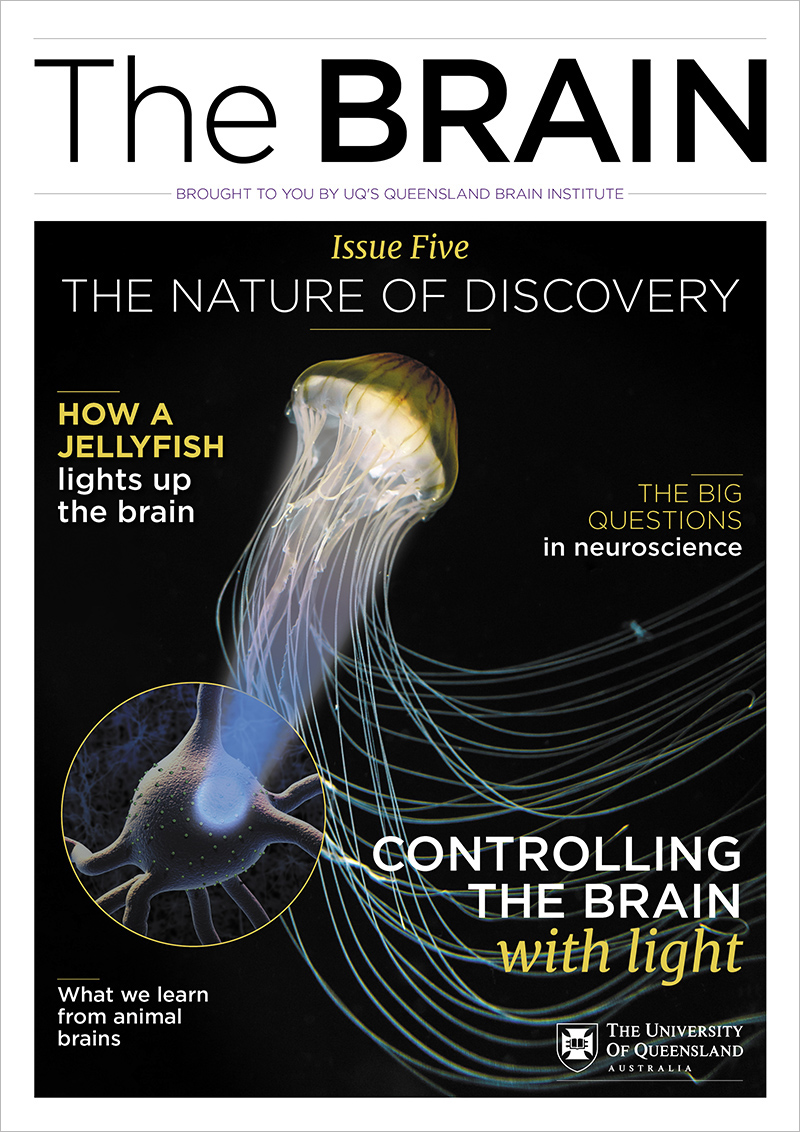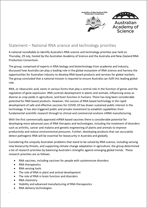Our researchers working on RNA in neuroscience are at the interface between the exciting world of RNA biology and the development of RNA therapies for mental health and neurological disorders.
We are focused on developing RNA-mediated cognitive enhancers for the treatment of phobia and PTSD, on microRNA as biomarkers for epilepsy and traumatic brain injury, on the role of RNA modifications in aging and schizophrenia, and on RNA-associated proteins determine progression of neurodegenerative disease.
By advancing the understanding of the qualitative nature of RNA, and by elucidating the importance of noncoding RNAs and RNA modification in the control of experience-dependent cellular activity, we will move beyond simple measures of RNA expression and their implied function toward a precise understanding of time- and location-dependent RNA functional states in brain. In doing so, high-resolution RNA based interventions that enable long lasting treatments for neurological disorders will be realised.
In the news
- ABC Nightlife: Junk DNA and the genetics of fear
- Mystery of neurodegenerative disease drives new research
- ‘Junk DNA’ key to controlling fear
- An 'astounding' find reveals a rare cause of epilepsy
- Mapping genetic roles to understand human development
- Stopping fearful memories relies on DNA flexibility
Events
Expertise: small ncRNA (microRNA, circRNA, piRNA, snoRNA), long ncRNA, RNA modifications, RNA localization, RBPs, RNA editing
The Bredy lab has made major advances in the field of RNA biology with the observation that various classes of noncoding RNA are instrumental for behavioural adaptation and memory, the broader impact of which is rapidly emerging. For example, they discovered that a brain-specific small noncoding RNA, called miR-128b, is critical for the formation of fear extinction memory, potentially by inhibiting molecular mechanisms of reconsolidation at the time of memory retrieval (Lin et al. Nature Neuroscience, 2011; Faculty of 1000 recommended). With collaborators in Australia, they established a role for long noncoding RNA (lncRNA) in mediating activity-dependent gene expression (Barry et al. Molecular Psychiatry, 2014; Web of Science Highly Cited). His group then determined the functional relationship between activity-dependent lncRNA activity and the formation of fear memories, which resulted in a landmark publication (Spadaro et al. Biological Psychiatry, 2015) and serves as an important foundation and bridge to an extensive research program on noncoding RNA biology where they are now investigating how lncRNAs interact with their protein-coding gene targets in different subcellular compartments to influence transcriptional regulation (Li et al. BioRxiv, 2021). Together with collaborators at the QBI, the team also provided the first characterisation of experience-dependent RNA modification in the adult prefrontal cortex, highlighting the importance of qualitative state changes in RNA as key post-transcriptional mechanisms of gene action (Widagdo et al. Journal of Neuroscience, 2016). Together, this work has pushed the conceptual boundaries of experience-dependent RNA metabolism in the brain and represents a new frontier in neuroscience. Professor Bredy has been invited to contribute reviews as a leading authority in the field, several of which are directly relevant to the research themes of the Centre. This includes very recent articles on the spatiotemporal expression of long noncoding RNAs and role in neural plasticity and memory (Liau et al, RNA Biology, 2021), the emerging function of RNA modifications in the brain (Nainor et al, Nature Neuroscience, 2016; Madugalle et al Trends in Neurosciences, 2020), and the influence of circular RNAs on learning and memory (Zajaczkowski and Bredy, The Neuroscientist, 2020).
QBI
Malformations of the neocortex arising from the inability to replenish the stem cell pool or undergo neurogenesis during embryonic life has profound consequences for an individual’s survival and quality of life. Moreover, perturbation of these critical developmental processes is directly implicated in autism spectrum disorders (ASDs). The Fragile X syndrome protein, FMRP, binds mRNAs to inhibit translation by forming a complex with Cyfip1 and the translation initiation factor EIF4E. The Cooper lab has identified a regulatory mechanism involving ASD genes that spatiotemporally controls Cyfip1 activity in neural stem cells in the developing mouse neocortex (Lee et al, Nature Comms 7:11082, 2016; O'Leary C, et al, Cell Rep 20: 370-383, 2017; Veeraval et al, Front Cell Dev Biol 8:6, 2020). Using gene editing and in utero electroporation approaches, they have developed mouse models to investigate the consequences of disrupting Cyfip function in cortical neural stem cells and in human induced pluripotent stem cells. Activity-induced mRNA translation within dendritic spines is essential for synaptic plasticity. The Cyfip-FMRP complex also negatively regulates the translation of many critical mRNAs in the spine, including NMDA and group 1 metabotropic glutamate receptors (NMDARs, mGluRs) and the morphogenic factor BDNF relieves translational repression by triggering Cyfip1 dissociation from FMRP-EIF4E. Using biochemical and calcium imaging techniques as well as super-resolution microscopy, the Cooper lab has recently demonstrated that their ASD gene regulatory pathway modulates Cyfip1-FMRP interactions during spine morphogenesis in response to BDNF-mediated synaptic stimulation, suggesting a pivatol role in synapse formation and transmission (manuscript in preparation).
First: Dr Xiaoying Cui has shown the long non-coding RNA (lncRNA) HOX-antisense intergenic RNA myeloid 1 (HOTAIRM1), is involved in the development of dopaminergic (DA) neurons. When interfering (si)RNA against HOTARIM1 are electroporated into the ventral midbrain of E11 mouse embryos, important factors in DA neuron specification are reduced while non-DA neurons appeared to be spared. Cellular systems appear to indicate EZH2, a histone methyltransferase may be involved.
Second: We have shown in humans that the developmental vitamin D-deficiency (DVD-deficiency) increases the risk of schizophrenia and impairs various aspects of brain development particularly that of DA neurons in animals. Dr Renata Pertile has recently sequenced the microRNA (miR) molecules in embryonic DA neurons sorted from E14 DVD-deficient mesencephalon. miRNAs are small non-coding RNAs that regulate gene expression post-transcriptionally. We have functionally analysed a number of dysregulated candidate miRs and show upregulation of miR-181c-5p suppresses neurite outgrowth of dopaminergic neurons.
3rd The EDiPS animal model (Enhanced Dopamine in Prodromal Schizophrenia) recapitulates the selective progressive increase in DA synthesis in the dorsal striatum that occurs in patients who transition to disease. RNA methylation, a post-transcriptional modulation, may be relevant in dopamine-mediated behaviours. When methylated RNA(m6A) immunoprecipitation (meRIP) sequencing was conducted on dorsal striatum from EDiPs animals Xiaoying Cui showed increased m6A RNA methylation in the EDiPs dorsal striatum. Consistent with this, there was increased expression of Mettl14 writer protein and the m6A reader YTHDF1 mRNA.
Expertise: Retrotransposons, pseudogenes
Professor Geoffrey Faulkner's team has led efforts to characterise the transcriptome of retrotransposons (repetitive elements) found in mammalian genomes. Through collaboration with the FANTOM (Functional Annotation of the Mammalian Genome) consortium, Prof Faulkner generated the first large scale survey of promoter elements and transcription start sites resident in retrotransposons (Faulkner et al., Nature Genetics, 2009). Notably, these promoters were remarkably tissue-specific in their expression and, in many cases, provided alternative transcription initiation for protein-coding genes. Prof Faulkner's team are currently focused on applying long-read sequencing (PacBio and ONT) to mammalian tissues as a way to catalogue new retrotransposon-derived RNAs; these efforts have also yielded a greatly expanded repertoire of transcribed pseudogenes (Troskie et al., Genome Biology, 2021). Prof Faulkner has authored numerous reviews on the transcriptome of repetitive elements (e.g. Mattick, Taft & Faulkner, Trends in Genetics, 2010; Jansz & Faulkner, Genome Biology, 2021).
Expertise: m6A RNA methylation, RNA binding proteins, CRISPR editing, post-translational modifications, synaptic neurobiolog. RBPs, RNA mods and lncRNA in plasticity, aging and stress
The Anggono lab's current research aims to elucidate the molecular mechanisms by which m6A (N6-methyladenosine) and related RNA binding proteins regulate activity-dependent gene expression during neuronal plasticity, and how aberrant dysregulation of the m6A signalling contributes to the pathophysiology of neurodegenerative diseases, such as Alzheimer’s and motor neuron disease.
RNA biology of neuronal plasticity
Dr. Victor Anggono and Dr. Jocelyn Widagdo
Synaptic Neurobiology Laboratory, Clem Jones Centre for Ageing Dementia Research, Queensland Brain Institute
Synaptic plasticity and long-term memory require de novo gene transcription and new protein synthesis. It is now well established that these two fundamental cellular processes are tightly regulated at the level of RNA (by non-coding RNAs, RNA modifications and RNA binding proteins). We provided the first evidence for a role of the long non-coding RNA, Meg3, in regulating the trafficking of AMPA-type glutamate receptors during neuronal plasticity (Tan and Widagdo et al., Frontiers in Cellular Neuroscience, 2017). One of the current goals of the laboratory is to elucidate the roles of post-transcriptional methylation of RNA on adenosine at the N6-position (termed m6A) in the healthy and disease brain (Widagdo and Anggono, Journal of Neurochemistry, 2018; Widagdo et al., Semin. Cell Dev. Biol., 2022). In collaboration with A/Prof. Tim Bredy (QBI, UQ), we were first to demonstrate the role of m6A RNA methylation in memory consolidation (Widagdo et al., Journal of Neuroscience, 2016). Subsequently, we identified a striking alteration in the expression of the m6A methyltransferase METLL3 in the postmortem human AD (Alzheimer’s disease) brain (Huang et al., eNeuro, 2020), suggesting that perturbation of m6A signalling may underpin dysregulation of gene expression associated with AD pathophysiology, and potentially other neurodegenerative diseases.
Our research in this field has also been extended to understanding the structure and function of RNA binding proteins. We identified an essential role of ubiquitin signalling in regulating the proteasomal degradation and nuclear translocation of the RNA demethylase, FTO (Zhu et al., Journal of Molecular Biology, 2018). More recently, work in collaboration with Dr. Mihwa Lee (La Trobe University) has identified a structural and molecular basis of the zinc-induced cytoplasmic aggregation of the RNA binding protein SFPQ (Huang et al., Nucleic Acids Research, 2020). This study provides a novel conceptual framework on how metal-induced polymerisation of RNA binding protein mediates cytoplasmic aggregation, a form of protein misregulation that is commonly associated with neurodegenerative diseases, including AD and MND (motor neuron disease or amyotrophic lateral sclerosis).
Expertise: microRNA
The Zuryn lab is part of the QBI at the University of Queensland and is interested in mitochondrial genome function and dysfunction and how this relates to disease. RNA-based mechanisms likely play an intimate role in the communication between the mitochondrial and nuclear genomes, which must function together to coordinate the assembly of oxidative phosphorylation protein complexes with nanoscale precision.We have recently developed techniques in the C. elegans model system for studying the cell-specific activities of microRNAs, a family of small RNA molecules with post-transcriptional gene regulation properties. Using this system, we have uncovered microRNAs that are activated upon mitochondrial stress signals and that function to protect cells from severe mitochondrial genome damage. The functional properties of these microRNAs show promise in protecting neurons against neurodegenerative diseases associated with mitochondrial dysfunction. The Zuryn lab is also interested in mitochondrial RNA modifications and how these control mitochondrial function.
The Walker group aims to define the roles of RNA-binding proteins (RBPs) in the pathogenesis of neurodegenerative diseases, particularly amyotrophic lateral sclerosis (ALS)/motor neuron disease (MND) and frontotemporal dementia (FTD). Dr Walker has revealed that disease-associated mutant RBPs induce cellular stress responses and drive formation of mRNA-sequestering stress granules (Walker et al. PLoS One, 2013, highly cited). The group has expertise in the testing of small molecule therapies in mouse models of neurodegenerative RBP proteinopathies (Wright et al. European Journal of Neuroscience, 2021), and maintains a long-standing industry collaboration to test custom RNA-targeted therapeutics in transgenic mice. They have a particular interest in leveraging new knowledge of the mechanisms of RBP dysfunction in disease to allow design of improved RNA-modulating anti-sense oligonucleotides and adeno-associated gene therapies. Dr Walker has shown that clearance of pathology formed by TDP-43, a key disease-associated RBP that regulates RNA splicing, allows for functional recovery in transgenic mice, suggesting new therapeutic avenues (Walker et al. Acta Neuropathologica, 2015). Current research in the Walker group employs whole-genome CRISPR screening to identify gene targets that regulate levels, solubility and toxicity of pathological RBPs such as TDP-43, which are characterised by aberrant RNA binding in disease. This work is being undertaken in collaboration with The University of Queensland Genome Innovation Hub and the Victorian Centre for Functional Genomics. Collaborative work of the Walker group has also identified aberrant neuronal transcriptional responses to cell stress related to neurodegeneration (San Gil et al. Journal of Cell Science, 2020), and early cortical hyperactivity in mouse models of ALS/FTD with TDP-43 pathology (Dyer et al. Journal of Neurochemistry, 2021). Recent reviews from the group have discussed advances in understanding the molecular pathways involved in RBP pathology in disease (Berning et al. Frontiers in Neuroscience, 2019).
CAI
Prof David Reutens - microRNA in epilepsy

MiRNAs are attractive candidate biomarkers to stratify the risk of post-traumatic epilepsy. As a current research project, the Reutens group is profiling the expression of miRNAs in the brain and blood after traumatic brain injury, focusing on miRNAs predicted to affect pathophysiological processes relevant to post-traumatic epileptogenesis such as cytokine regulation, cell death, synaptic remodelling, and blood-brain barrier dysfunction.
Dr Min Chen is working with Professor Reutens on the miRNA profiling project in the post-traumatic epilepsy model. We have observed that the profile of microRNA changes following immunomodulatory treatment that improved functional outcome in a mouse model of TBI overlapped with microRNAs in exosomes. We are interested in exploring the potential of modulating the inflammatory response using miRNA-bioengineered exosomes to reduce brain damage, improve recovery of motor and cognitive functions, and modify or prevent susceptibility to post-traumatic epilepsy.
SBMS

RBPs in MND
Our lab uses genetically modified mice, and in vitro motor neuron culture systems to investigate these issues. Details of our recent work and future direction are given below.
We have shown that TDP-43, a protein involved RNA metabolism and transport, is capable of binding to mRNAs that encode for proteins needed for synaptic transmission such as Syntaxin, Synaptophysin, and voltage gated Ca2+Channels (Narayanan et al, 2012 ALS). Recently, we have shown when this protein is mutated in motor neurons that have been subjected to stress, mutated TDP-43 but not normal TDP-43 is translocated to stress granules. This translocation stalls mRNA translation (Ding et al., 2021 Front in Cell & Dev Biol. 9:611601).
We have recently established human motor neuron muscle – 2D microfluidic system and are intending on using this system to look at activity dependant transport and translation of pre-synaptic mRNAs. Induction of motor neuron activity in these systems will be via optogenetic and or chemogenetic activation of transfected human stem cells that will be induced into upper and lower motor neurons. We also intend to develop mouse models whereby we can module motor neuron activity output – optogenetic (acute activation) and chemogenetic (chronic). To investigate these issues in an intact neuromotor system.
AIBN

Expertise: Long noncoding RNAs and biotech
The human genome expresses vast numbers of noncoding RNAs (ncRNA) that fulfill diverse roles in gene regulation, cell biology, development and human disease. These roles are usually mediated by sequence motifs and secondary structures that are bound by proteins and can regulate epigenetic, transcriptional and translational pathways. These functional domains can be optimised and engineered into RNA devices that are commonly used in synthetic biology. We propose that natural ncRNAs comprise a promising basis for the discovery and development of RNA therapies to treat human disease. Accordingly, the Mercer laboratory is focused on the rational design and assembly of synthetic RNA therapies and biotechnologies. Our laboratory has capabilities in the computational design of synthetic RNAs tailored according to precise custom requirements, enzymatic DNA synthesis to build genes, genomes and libraries, and the in vitro manufacture of high-quality RNAs for in vivo therapeutic applications.
Keywords: splicing, noncoding RNAs, RNA manufacture, synthetic RNA therapies and biotechnologies.

Expertise: lncRNA, circRNA
The Wolvetang group at AIBN-UQ has a longstanding interest in understanding the roles of non-coding RNAs in the human brain. We identified the first two neuronal activity dependent LncRNAs in the brain revealing that NEAT1 is responsive to neuronal activity and hyperactive in epilepsy models (Barry et al. Scientific Reports. (2017) Jan 5;7:40127, highly cited paper) and linking GOMAFU to schizophrenia (Mol.Psych. (2014) Apr;19(4):486-94.), and wrote a highly cited review paper on the subject (Briggs et al Neuron (2015) 88(5), 861-877). Our expertise lies in genome editing of human patient specific pluripotent stem cells and the establishment of human brain organoid models that are extremely well-suited for interrogating the function of coding and non-coding RNA species in human brain development and disease or for testing of RNA-based therapeutics. We further have expertise in interrogating the transcriptomes of neural cell types in human brain organoids via scRNAseq or through in situ detection of RNA species with RNA scope, and have established high density multi electrode array based methods that are able to quantify neuronal activity and connectivity in our human cellular model systems. We have developed a particular interest in exploring the functional roles of circRNAs at the synapse and in evaluating their potential as cell type specific biomarkers of disease and have recently started to use our models to explore the impacts of viral pathogens such as ZIKA virus (Slonchak et al BioRxiv (2021) https://doi.org/10.1101/2021.05.18.444753, Setoh et al Nature Microbiology (2019) May;4(5):876-87), and COVID19 (paper in prep) on the human brain, providing novel opportunities for testing of RNA-based therapeutics.
IMB

Expertise: Spatial transcriptomics
Nguyen group is investigating neuroinflammation and cancer ecosystem by integrating advanced transcriptomics technologies and machine learning analyses. The group is pioneering the applications of spatial transcriptomics and single-cell sequencing to study transcriptional regulations at cellular resolution and within physiological tissue context.
For technology applications, the group has developed advanced sequencing approaches to study the transcriptome. We have established a low-cost and high-throughput sequencing protocols to detect long non-coding RNA, by developing an improved version and the first application of Capped Analysis of Gene Expression (CAGE) in Australia. We invented a new way to capture and quantify rare, functional small RNA (Nguyen et al., Nat Protocol, 2018). The method was applied to identify a new class of small RNA needed for DNA damage repair (Rossiello et al., Nat Communications, 2017). Recently, using single-cell RNA sequencing (scRNAseq), we constructed a comprehensive single-cell immune atlas of spinal cord injury, finding differential responses across time and space (Manuscript in preparation). We pioneered spatial transcriptomics sequencing (STseq), a method to profile the whole transcriptome of thousands of tissue regions, while preserving tissue morphology. We produced the first STseq data set of a traumatic brain injury model, confirming the spatial enrichment of activated astrocytes in the hippocampus region during injury repair (Willis et al, Cell, 2020). For patient samples, our lab developed a protocol for performing spatial sequencing of formalin fixed tissue sections (FFPE), including those with partially degraded RNA. The FFPE spatial method opens the potential for studying spatiotemporal changes in a vast collection of clinical samples.
For data analysis, the group has developed advanced computational and statistical methods to analyse genomics data. We have produced eight software programs and a range of analysis pipelines. We created two pioneered spatial analysis programs widely used by researchers worldwide for automated cancer cell identification (Tan et al., Bioinformatics, 2019 - SpaCell, >5000 downloads) and cell-type, cell progression and cell-cell interaction spatial data analysis (Pham et al., 2020, bioRxiv125658 - stLearn, >20,000 downloads). The analyses have found new classes of cancer markers that involve cellular phenotypes such as cell shape (Bioinformatics, 2019), cell-cell interaction (Pham et al., 2020, bioRxiv125658; Tran et al., 2020, bioRxiv290833), and spatial distribution (Tran et al. J Immunother Cancer, 2020; Artificial Neural Network, 2020). In addition, we demonstrated the successful combination of histological images with sequencing data in a model to improve the accuracy of the cell classification accuracy in the brain and cancer (Tan et al. Bioinformatics, 2019; Pham et al., 2020 bioRxiv125658) and to study transcriptional regulation specific for each anatomical region across the tissue (Pham et al., 2020, bioRxiv125658).
UQCCR

Expertise: Clinician researcher-neurologist with a special interest in epilepsy
Neurological disorders are a major cause of death and disability in our society. Of greatest concern is the absolute increase in disability-adjusted life years for neurological conditions over 15 years (2003-2018), highlighting the imperative need for new therapeutic strategies such as RNA therapeutics.
Our research focus is to move from symptomatic treatment for patients, which occurs in a reactive fashion, to a more proactive treatment approach of developing innovative therapeutic strategies based on the underlying pathology. RNA biology holds great promise for better understanding the cause and enabling the development of novel therapeutic targets, to improve the outcome of neurological disorders.
Dr Laura Leighton
I am a postdoc in Dr Tim Bredy’s lab at QBI with broad interest in RNA biology, and a particular focus on small noncoding RNAs and epitranscriptomics. I am currently working on small nucleolar RNAs and investigating the function of ‘orphan’ snoRNAs with non-canonical targets which are involved in regulation of learning and memory. I also love the breadth of creative methods that are emerging in the RNA space and am working on adapting techniques for examining RNA modifications and structure for the challenging sample types typical of neuroscience research.
Current funding
UQ postdoctoral fellowship
Seed grant from the Prader Willi Research Foundation of Australia.
Dr Rebecca San Gil

Rebecca is a postdoctoral fellow in Dr Adam Walker’s lab at QBI investigating the dysfunction of the RNA-binding protein, TDP-43, in motor neuron disease (MND) and frontotemporal dementia (FTD). My research investigates the transcriptome and proteome in cell and animal models of these diseases to advance our understanding of the biological processes that drive MND and FTD. In addition, I have applied genome-wide single guide RNA libraries for the CRISPR/Cas9 knockout of individual genes in pooled functional genomics screens to identify genes mediating TDP-43 dysfunction in disease.
Dr Min Chen
I work with Professor Reutens on miRNA profiling in the post-traumatic epilepsy model. We have observed that microRNAs change following immunomodulatory treatment and that improved functional outcome in a mouse model of TBI overlaps with microRNA expression in exosomes. We are interested in exploring the potential of modulating the inflammatory response using miRNA-bioengineered exosomes to reduce brain damage, improve recovery of motor and cognitive functions, and modify or prevent susceptibility to post-traumatic epilepsy.
Dr Xiaoying Cui

I have shown the long non-coding RNA (lncRNA) HOX-antisense intergenic RNA myeloid 1 (HOTAIRM1) is involved in the development of dopaminergic (DA) neurons. HOTARIM1 knockdown in the ventral midbrain of E11 mouse embryos reduces the expression of DA neuron specification factors while non-DA neurons appear to be spared. The histone methyltransferase EZH2 may be involved. My recent research focuses on how RNA methylation mediates dopamine-related behaviour in an animal model of schizophrenia. I have shown that enhanced dopamine synthesis promotes RNA methylation in the striatum. My future study will determine whether RNA methylation is the critical mechanism mediating the behavioural phenotype relevant to schizophrenia.
Dr Wei-Siang Liau

My research aimed at elucidating the function and activity of long non-coding RNAs at the synapse. I am particularly interested in how the activity of long non-coding RNAs and RNA modifications regulate the formation and maintenance of fear extinction memory. In addition, I am also interested in how small peptides derived from long non-coding RNAs affect synaptic plasticity and memory.
Dr Belal Shohayeb

I am a Post doc in Prof. Helen Cooper’s lab at QBI where I investigate synaptic plasticity, the cellular basis of learning and memory. The neuronal activity followed by long-term potentiation results in structural and compositional changes in excitatory synapses. This includes actin polymerization and protein synthesis which are tightly coupled. These processes are mediated by changes in the composition of protein complexes on the spine head and the release of mRNA for translation. We study how these processes are regulated and what are potential targets on the spines that may alter actin polymerization and mRNA translation/protein synthesis.
Dr Adekunle Bademosi

Adekunle is a postdoctoral fellow of Race Against Dementia – Dementia Australia Research Foundation at the Walker Lab. He uses advanced single-molecule imaging techniques to study the normal and pathological role of the RNA binding protein - TDP-43 in Motor neuron disease and Frontotemporal Dementia. He aims to shed light on the precise mechanisms involved in TDP-43 aggregation and how this might be stopped or reversed at nanoscale resolution. Further, he aims to characterise how altered RNA binding might alter the overall dynamics of TDP-43 in disease.
Professor John Mattick AO FAA FTSE FAHMS

John Mattick is best known for showing that the majority of the human genome is not junk but rather is dynamically transcribed to produce not only mRNAs but also hundreds of thousands of small and long non-protein-coding RNAs (lncRNAs) that control cell and developmental biology. He has published over 300 scientific articles, which have been cited over 83,000 times. He was the first to propose that regulatory RNAs control development (Current Opinion in Genetics and Development 1994; Molecular Biology and Evolution, 2001; Nature Reviews Genetics 2004, 2009, 2014; Scientific American 2004) With his colleagues he discovered ultraconserved elements in the human genome (Science, 2004), showed that lncRNAs are dynamically expressed during differentiation and development (Genome Research, 2008) including neuronal differentiation (BMC Neuroscience, 2010), and are specifically expressed in hippocampus, cortex and cerebellum (PNAS, 2008), some of which he is currently knocking out to examine their roles in brain development, learning and behaviour. With Tim Mercer and colleagues, he proposed the modular structure-function of lncRNAs (Nature Structural and Molecular Biology, 2014) and developed new methods for high resolution transcriptome analysis (Nature Biotechnology, 2012), which revealed the almost universal alternative splicing of lncRNAs (Cell Systems, 2019). He has completed a book entitled “RNA, the Epicenter of Genetic Information”, to be published in mid-2022. His awards include the University of Texas MD Anderson Cancer Center Ernst W. Bertner Memorial Award for Distinguished Contributions to Cancer Research, and the Human Genome Organization Chen Award for Distinguished Achievement in Genetic and Genomic Research.
Book: RNA, the Epicenter of Genetic Information
Professor Tony Hannan

Professor Anthony Hannan’s team provided the first demonstration in any genetic animal model that environmental stimulation can be therapeutic (van Dellen et al., 2000, Nature). This has led to new insights into gene-environment interactions in various brain disorders, including Huntington’s disease, dementia, depression, schizophrenia and autism spectrum disorders. His laboratory explores how genes and the environment combine via experience-dependent plasticity in the healthy and diseased brain. Their research includes models of brain disorders which involve cognitive and affective dysfunction, investigated at behavioural, cellular and molecular levels so as to identify pathogenic mechanisms and novel therapeutic targets. In recent years his group has been exploring transgenerational epigenetic inheritance of acquired traits in response to paternal environmental exposures and experience. They have shown that non-coding RNAs in sperm can be modulated by stress hormones, exercise and other experience-dependent factors (e.g. Short et al., 2016, 2017, Translational Psychiatry; Yeshurun & Hannan, 2019, Molecular Psychiatry). Other RNA-related interests including tandem-repeat transcriptomics (e.g. Hannan, 2018, Nature Reviews Genetics). www.florey.edu.au/epigenetics-and-neural-plasticity-laboratory
Professor Murray Cairns

Professor Murray Cairns is interested in understanding the role of genetic and epigenomic variation in synaptic function and psychiatric disorders (Kiltschewskij and Cairns NAR 2019). His research has focused on transcriptional analysis of schizophrenia and the role of non-coding RNA, particularly small transacting miRNA and their interaction with mRNA and competing endogenous RNA. These networks can have tremendous influence through posttranscriptional regulation of gene expression. Alteration of these posttranscriptional networks may be useful biomarkers of disease state and can reveal new targets for therapeutic manipulation through systems biology. Professor Cairns’ research more broadly is exploring the use of genomics in precision medicine for complex disorders (Reay and Cairns, Nature Reviews Genetics 2021).
A/Professor Kelly Clemens

A/Professor Kelly Clemens is a behavioural neuroscientist working at the interface between molecular biology and mental health. A major focus of her group is how drug use can lead to epigenetic changes (histone modifications, DNA-methylation) that regulate the expression of genes critical to the development, maintenance and relapse of drug addiction. This includes how long non-coding RNA may recruit regulatory proteins to influence gene expression, and whether these lncRNA can be targeted to reverse the impact of drug use. A second emerging research focus of the Clemens group is investigating how prenatal opioid exposure leads to epigenetic changes in the brain that may underlie poor long-term mental health and cognitive outcomes across development.
A/Professor Irina Voineagu

A/Professor Irina Voineagu is a molecular biologist interested in how gene expression is regulated in the normal human brain and how it is disrupted in neurodevelopmental disorders. One of the major areas of focus is the investigation of non-coding regulatory elements such as enhancers through high-throughput CRISPRi screening in brain cells. Her group also investigates how non-coding RNAs, in particular circular RNAs, are involved in gene expression regulation, and the mechanisms underlying their biogenesis. www.voineagulab.org.
Professor Carl Walkley
Cancer and RNA Biology Laboratory, St Vincent’s Institute
ORCID

My research program focusses on understanding the role of RNA regulation in normal biology, in particular the role of A-to-I RNA editing mediated by ADAR proteins. We have used in vivo genetics to determine the essential physiological functions of ADAR1 and to gain a better understating of the functions of A-to-I RNA editing in normal development and homeostasis. We are interested in understanding how A-to-I editing, and other RNA binding proteins that intersect with ADAR1 biology, contribute to normal brain function and behaviour.









 AAS Statement on RNA science and technology priorities
AAS Statement on RNA science and technology priorities